|
|
How the Shakers Invented Spiritualism
The Ecstatic Spirits of Holy
Hill
Harvard Massachusetts
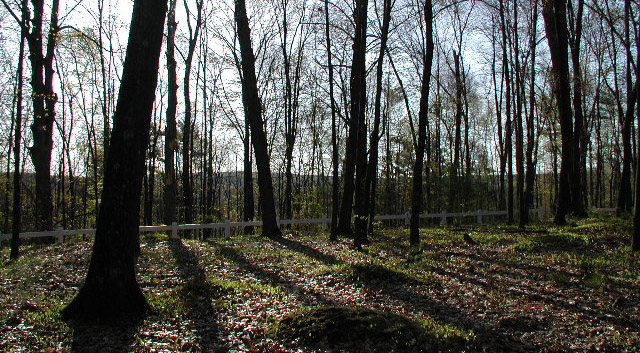
Field Investigations:
11 August 2002 & 30 May 2007
by Daniel V. Boudillion
|
Note: this is the full
text of the abbreviated version published in the book Weird Massachusetts
Introduction
The Shakers are known for
their many inventions, but did you know that one of these was modern
Spiritualism? And, that they had ecstatic meetings on a Holy Hill in
Harvard that were attended by upwards of 40,000 spirits at a whack?
Including the Angel of Victory, Noah, the Virgin Mary, and throngs of
Indian spirits anxious to become Shakers?
Who Were the Shakers?
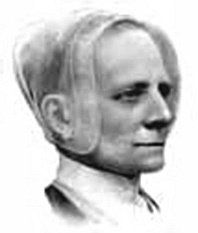 The United Society
of Believers in Christ's Second Appearing first came to Harvard,
Massachusetts, from England in 1781. They were searching for a place
that their leader, Mother Ann Lee, had seen in a vision prior to coming
to America. That vision was realized as the little valley in Harvard
that eventually blossomed into the Harvard Shaker Community. The United Society
of Believers in Christ's Second Appearing first came to Harvard,
Massachusetts, from England in 1781. They were searching for a place
that their leader, Mother Ann Lee, had seen in a vision prior to coming
to America. That vision was realized as the little valley in Harvard
that eventually blossomed into the Harvard Shaker Community.
The term Shaker
was a derisive name given to them by non-Believers who had observed
their practice of whirling and trembling to
"shake off" the sins of the
world in their ecstatic dance-filled meetings. These meetings were open
to the public (called
"The World" by Shakers) and many people regularly
attended to watch the spectacle.
The basic tenets
of Shakerism were celibacy, communal life, and confession of sin. Other
important beliefs were separation from the world, equality of the races
and genders, and pacifism. Shakers believed that their founder, Mother
Ann Lee, embodied the second coming of the Christ spirit as manifested
on Earth. They also were Millennialists. They believed that the second
coming of Christ had occurred and that they were living Saints of the
Second Coming.
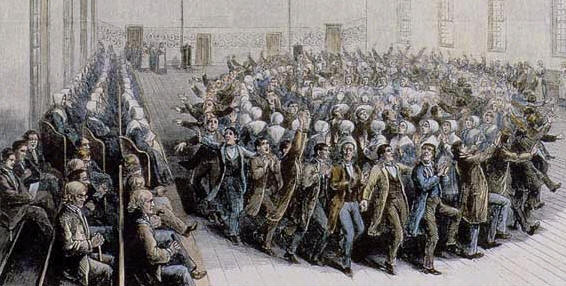
Shaker's dancing while "The World"
watches from the sidelines
An Inventive Society
The Shakers are credited with a
long list of innovations and inventions. These inventions include the
flat broom, the screw propeller, a pea sheller, a threshing machine, the
metal pin, an apple parer and corer, a turbine water wheel, a revolving
oven, the circular saw, the common clothespin, and an industrial washing
machine. Being a humanitarian Society, these inventions were rarely
patented.
It is no surprise that their
spiritual life was also inventive and a step ahead of its time, and
perhaps even still so today.
Visions & Spirits
Spirits and the
Spirit World were an integral part of the original Shaker teachings of
Mother Ann. She had many visions and described them to her attentive
followers.
Her teachings
stated that the offer of the Gospel was free to all souls, be they alive
or in the spirit world, and that none could be denied it simply because
they were dead. She often saw visions of the dead being brought to
salvation. She had visions of meeting with angels and of conversing
with Old Testament prophets and she reported the mighty doings of
deceased Shakers
"in the world of spirits" converting the dead. She
would address the spirits in unknown tongues, and had visions in which
she saw herself with
"great wings" flying though a gulf in the Spirit
World populated with unsaved souls, bringing them to salvation.
These glimpses of
the Spirit World almost exclusively came from the visions and seership
of Mother Ann as described by her. But fifty years after her death in
1784, an amazing period of Shaker history arose in which the outpourings
of the Spirits and Spirit World would be expressed front and center on
the Shaker stage. It would be a time in which any and all Shakers would
bring through the voice and messages of the Spirits, not only as visions
but in real-time channelings and possessions.
The Story Begins with an Ending
Mother Lee died in Watervliet, New York, in
1784 and was buried there in a local cemetery. In 1835 her remains were
moved to a Shaker owned cemetery in the
Watervliet Community.
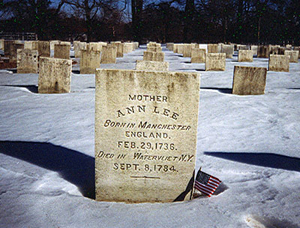
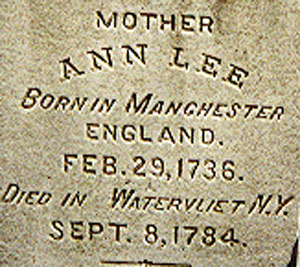
Mother Ann's Grave
Perhaps the re-interment
disturbed the spirit of Mother Ann. Perhaps the return of her remains
from the secular world to within the holy body of the Shaker Community
of "Wisdom’s Valley" after 50 years aroused it to a new spiritual life.
It is no coincidence that the following 10 years were known throughout Shakerdom as Mother Ann's Second Appearing, also known as the New Era,
and Mother Ann's Work.
Indeed, the Spirit of the New
Era moved throughout the entire Shaker Community. In 1837, at the site
of Mother Ann's re-interment in Watervliet, it was reported that several
young teenage girls simultaneously began to shake and tremble with
extraordinary intensity. They whirled around their schoolroom until
they fainted to the floor in a deep trance. Upon awakening the girls
relayed greetings from the "spirit land" and recounted tales of trips to
the heavenly worlds. Soon this phenomenon spread to other teens
and to adults in other Shaker Communities. But it did not become a
codified part of Shaker practice until it reached and affected Elder
Philemon Stewart in
New Lebanon, New York in early spring of 1838.
In short, he became a "chosen instrument," as they called it, for direct
communication from Jesus and Mother Ann, among others.
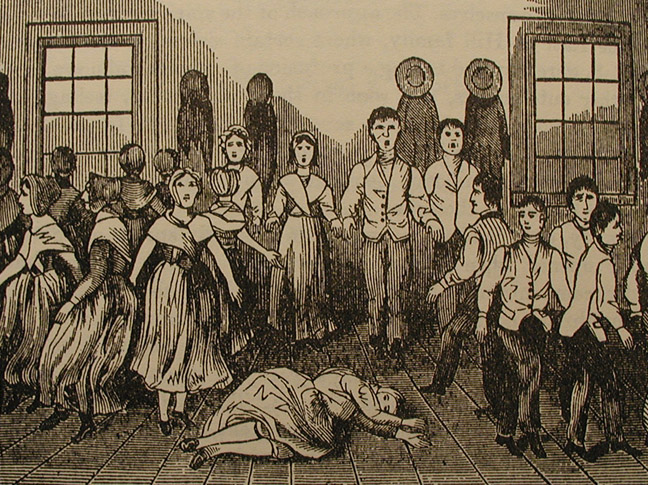
Shaker girl falling to the floor in
trance
Taking the "Lead" from New Lebanon
Elder Steward's involvement was
pivotal to the spread of the New Era. He was the head of the "lead" in
the "lead" Shaker community of New Lebanon. Steward was a man of
indomitable will and his commands were followed throughout Shakerdom
absolutely. It was from revelations of the "lead" that rules and
regulations were disseminated and absolute adherence was required.
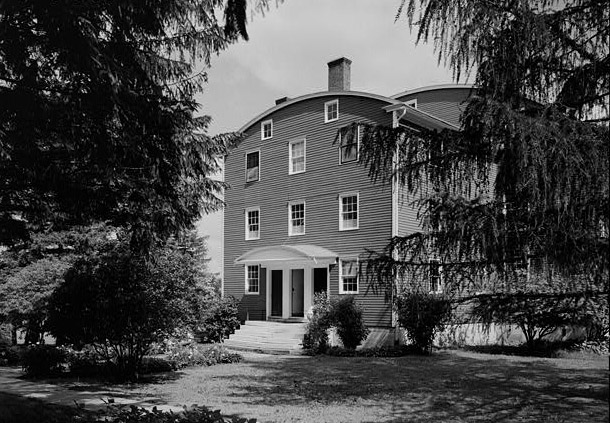
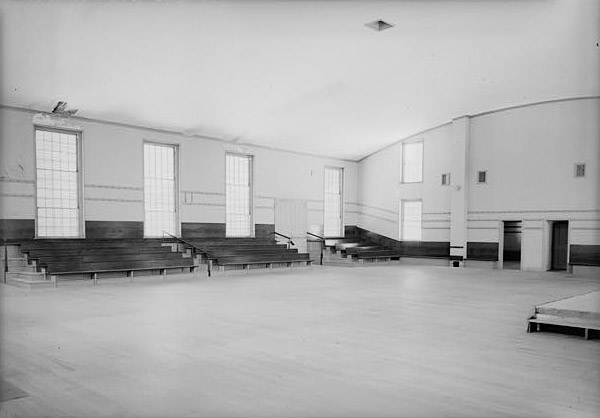
New Lebanon (Mount Lebanon) Shaker
Meeting House
New edicts called "gifts," or spiritual revelations traveled like
electricity throughout Shakerdom from the "lead" of New Lebanon.
Initial instructions were for the various Shaker Communities to cleanse
and purge themselves of all non-Shaker worldliness. For the next seven
years, many more edicts and "gifts" of the unfolding spiritual nature of
Mother Ann's Second Appearance followed.
With the last of
the original Shakers dying off, it was believed that Mother Ann was
sending her Spirit to revive and refresh the faith of a new generation
who believed that a new spiritual age was imminent.
The Lovely Vineyard
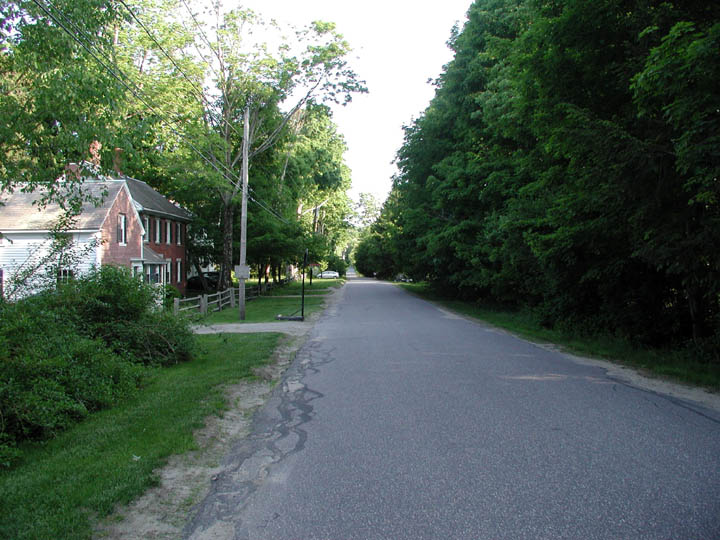 In the Harvard, Massachusetts,
Shaker Community something was certainly brewing in the air early on.
As early as March of 1835, a diarist there noted it to be a "time of
great awakening, confession, and repenting." In the Harvard, Massachusetts,
Shaker Community something was certainly brewing in the air early on.
As early as March of 1835, a diarist there noted it to be a "time of
great awakening, confession, and repenting."
Following the initial "gift"
from New Lebanon in 1838 regarding spiritual housecleaning, they swept
clean the entire community with imaginary spiritual brooms and continued
to do so yearly. In 1839 it is recorded that the spirit influence had
indeed arrived in Harvard; there were many lively meetings with "testimony
from Spirits brought forward through a mortal instrument."
These mortal instruments were typically young women from the ages of 13
to 25.
By January 1841,
the spiritualism and clairvoyance of Mother Ann's Work was firmly
established in the
Harvard Shaker Community. When Abijah Worster died
on the 10th of that month, a young
"inspired" Shaker girl
stood by the door to take down the names of those old friends from the
spirit world who were expected to attend his body to the grave and honor
his funeral.
As the outpourings of Spirit
unfolded, the "lead" of New Lebanon revealed an elaborate ritual for the
Healing of Nations in the spring of 1842. This "gift"
required each Shaker community to build a holy place of worship (a
spiritual feasting ground) on a nearby hill to be used for semiannual
all-day Spiritual Feasts in May and September. Each location was
to have a special spiritual name, and the communities themselves were
also given special spiritual names. Harvard Community became known
as Lovely Vineyard, and their worship place was christened the Holy Hill
of Zion.
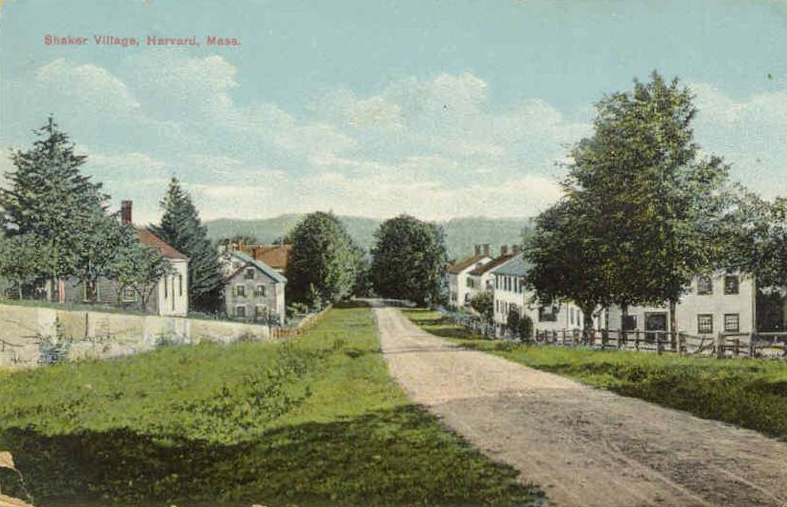
Main Street, Lovely Vineyard, Harvard
Massachusetts
Harvard was quick to espouse and
unfold the new outpouring of Mother Ann's Work. In fact, the community
had already begun work on Holy Hill by October of 1841, well in advance
of the "gift" directive from New Lebanon.
|
The Fountain of Youth Found
The Harvard Shakers' Miraculous Spring
Water
by Daniel V. Boudillion
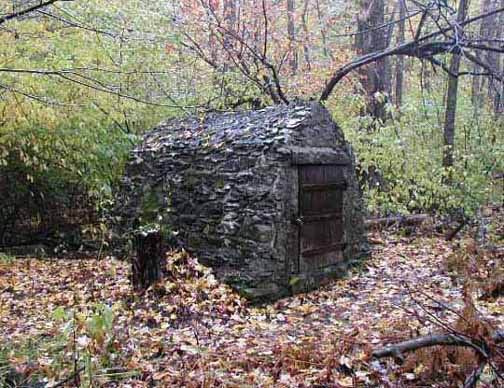 The
longevity of Harvard Shaker Community was remarkable. In the
1880’s, the average lifespan of a Harvard Shaker was just over
seventy years of age. It would be another 50 years before the
general populace were to equal that. A casual walk through the
Harvard Shaker cemetery reveals an unusual number of long lived
community members, and ages in the 90’s are not uncommon. The
longevity of Harvard Shaker Community was remarkable. In the
1880’s, the average lifespan of a Harvard Shaker was just over
seventy years of age. It would be another 50 years before the
general populace were to equal that. A casual walk through the
Harvard Shaker cemetery reveals an unusual number of long lived
community members, and ages in the 90’s are not uncommon.
The Harvard Shakers were
in no doubt as to the reason of their extraordinary health and
longevity. They had a special spring from which the entire
community drank exclusively. In fact, they claimed a 16% increase
in lifespan from its waters alone.
For the rest of the article, see
here.
|
The Holy Hill of Zion
The feast grounds, as they were
originally called, were required to be on a high point of land close to
the community. However, according to the "lead" of New Lebanon, the
exact location was to be chosen by spirits speaking through the "chosen
instrument" of the local Shakers. The Harvard "instruments" were lead
to chose a nearby 120 foot tall hill about 700 yards west of the central
Church Family location. It is a long narrow hill running on a due
north-south axis and about a half mile long.
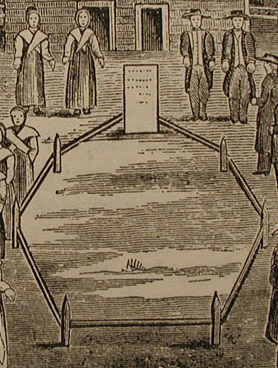 Over the course of two years the Shaker
Brethren transformed the top northernmost end into a half-acre square
plateau. They carved off the rounded top and used it for fill along the
sides and end of the hill. This area was enclosed with a wooden fence.
In the center a hexagonal area on a north-south axis, about 11 feet long
and 5 feet wide was enclosed with a low shin-high fence. (See picture to
the left.) This was known
as the Fountain, an area of energetically upwelling spiritual
blessings. At the northern end of the Fountain area was erected a
marble slab variously known in the different Shaker Communities as a
Fountain Stone, God Stone, or Lord's Stone. It was engraved as follows: Over the course of two years the Shaker
Brethren transformed the top northernmost end into a half-acre square
plateau. They carved off the rounded top and used it for fill along the
sides and end of the hill. This area was enclosed with a wooden fence.
In the center a hexagonal area on a north-south axis, about 11 feet long
and 5 feet wide was enclosed with a low shin-high fence. (See picture to
the left.) This was known
as the Fountain, an area of energetically upwelling spiritual
blessings. At the northern end of the Fountain area was erected a
marble slab variously known in the different Shaker Communities as a
Fountain Stone, God Stone, or Lord's Stone. It was engraved as follows:
On the back: "Written and
placed here By the command of our Lord and Saviour Jesus Christ THE
LORD’S STONE Erected upon this Holy Hill of Zion November 23d, 1843.
Engraved at Harvard."
On the front: "For the
healing of the nations, who shall here seek my favor. And I will
pronounce all people who shall come to this fountain, not to step within
its this enclosure, nor place their hands upon this stone while they are
polluted with sin. I am God the Almighty in whose hands are
judgment and mercy. And I will cause my judgments to fall upon the
willful violator of my commands in my own time according to wisdom and
truth, whether in this world, or eternity. For I have created all
souls, and unto me they are accountable. Fear ye the Lord."
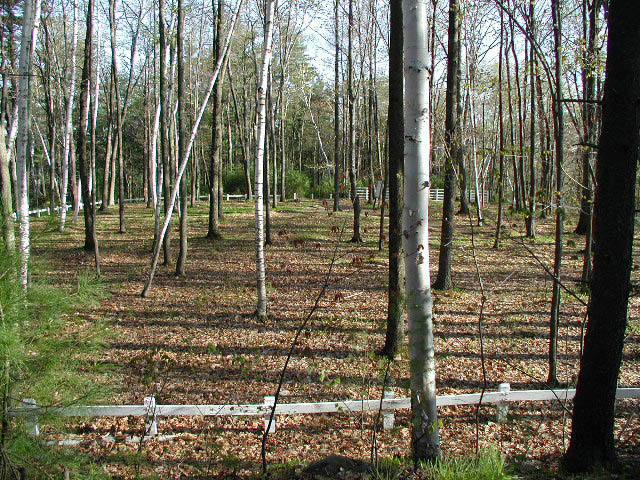
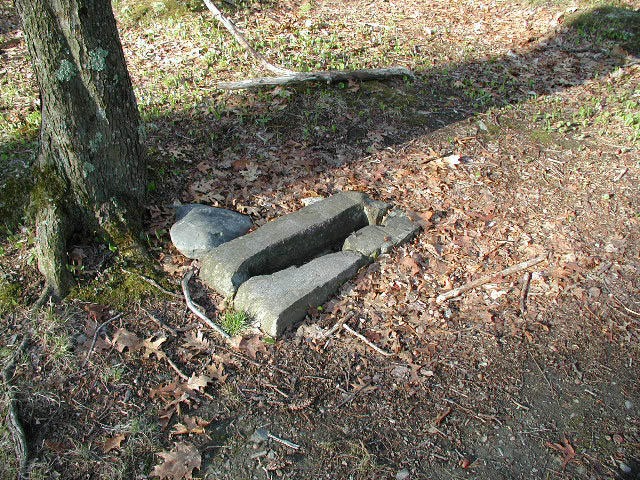
Holy Hill of Zion Dancing Ground &
Fountain Stone Footing
The feast grounds (dancing grounds) in each Shaker community
were set up very similar to this, each with its Fountain area and
Fountain Stone. The only surviving Fountain Stone is from the Groveland
"Union Branch" Shaker Community and is on exhibit at the New York State
Museum.

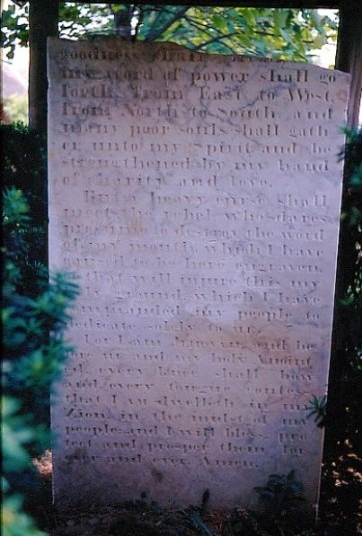
Harvard &
Groveland Fountain Stones
Sacred Indian Sites?
Interestingly, Brad Olsen, in
Sacred Places of North America, believes that "most of these hills were
originally Native American worship sites." Indeed, artifacts found on
Mount Sinai in the Hancock Shaker community indicate that the peak was
sacred to local Indian tribes.
Some researchers including
Olsen, but most specifically James Mavor and Byron Dix in Manitou,
believe that Indian ritual was incorporated into Shaker ceremony and
that the choice of Indian ritual locations by Shaker "instruments,"
particularly in Harvard, was intentional. Mavor & Dix go as far to
suggest that these Indian sites were maintained by the Shakers along
with the Indians, and then later on their own. Certain lithic
structures in the Harvard area are given as examples of Indian activity
on what became Shaker lands.
According to them, these include
large perched boulders, balanced rocks, standing stones, stone mounds,
unusual stone rows, prayer seats, artificial rock shelters, and ditch
and bank earthworks. Two of these, a rocking stone and a standing
stone, may be seen near the trailhead on South Shaker Road in Harvard.
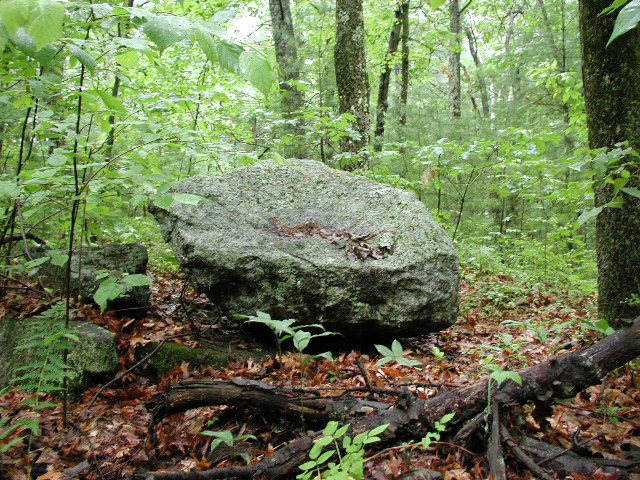
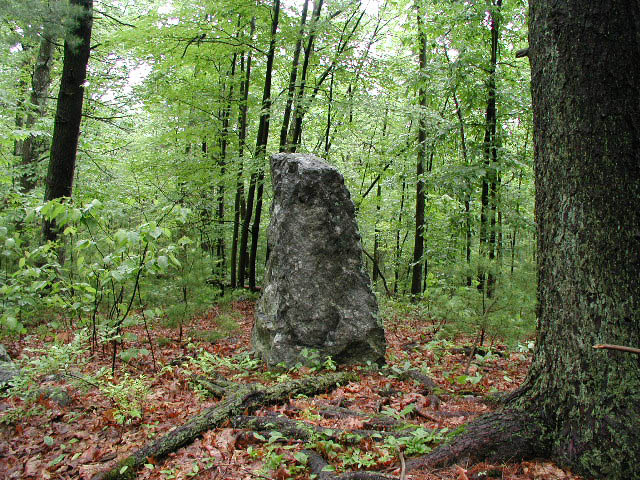
1 Ton Rocking Stone & nearby Standing
Stone
Certainly Indian spirits played
a major role in the New Era of Mother Ann's Work between 1838 and 1844,
but there is no hard and fast evidence for collaboration with actual
Indians themselves. At best, Mavor & Dix provide circumstantial
evidence in Manitou, and perhaps sum it up best in their own
words as a "curious
affinity between the Shakers and the Indians."
Meetings on Holy Hill
The first recorded mention of
meetings of the Lovely Vineyard Harvard Shakers on the Holy Hill of Zion
was on August 29, 1842. This was well before the Holy Hill was
completed, but it can be assumed from the entry that they had been
meeting there from at least the summer of 1841. Over the next few years
these spiritualist-type meetings were to become such an obsession that
in August of 1842 there were up there almost every other day, and the
meetings were lasting up to six hours on each occasion. So much time
was spent in spiritualist activity that the crops languished and the
only substantial harvest for several years was spiritual, as was noted
by some of the more pragmatic members.
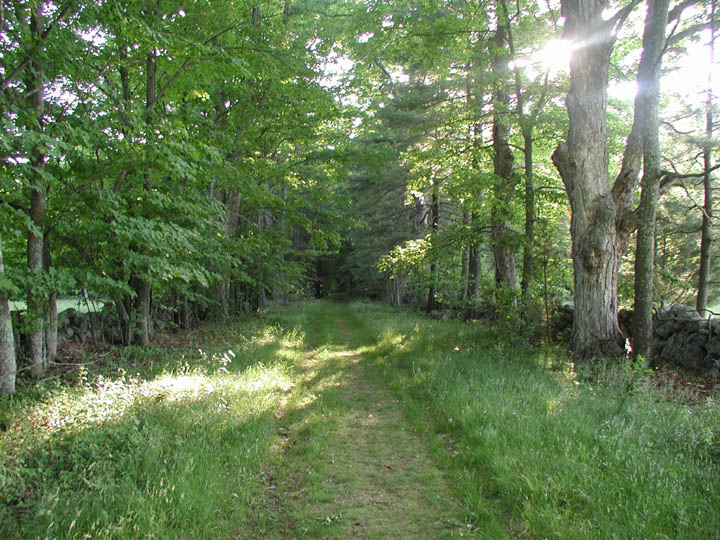
Processional Avenue to Holy Hill of
Zion
On meeting occasions, the Holy
Hill was approached in procession along an avenue of maple trees. The
procession would then ascend the north end of the hill in two columns,
one of Brothers and one of Sisters, and thus enter the enclosed feast
grounds from the North.
An eyewitness account from
nearby Shirley Shaker Village relates that during the procession they
"threw love" to each other by throwing both hands forward, and the
recipient drawing the hands back to the heart.
This favorite Marching Song was
sung on the precessions to the Holy Hill of Zion:
I shall march through Mount Zion
With my angelic band,
I shall pass through the city
With my fain in my hand,
And around thee, O Jerusalem,
My armies will encamp,
While I search my Holy Temple
With my bright burning lamp.
Dancing & Pageantry on Holy Hill
On Holy Hill in their day-long
(and occasionally night-long) meetings the 80 to 90 Brother and Sister
Harvard Shakers found a particularly intricate and ecstatic form of
worship in the dance. They would dance round and round the fountain,
spinning and whirling rhythmically. They would march and sing for
hours, swaying in unison. Whirling like a top, a "chosen instrument"
would fall to the ground in a faint, to arise conversing with departed
spirits and in unknown tongues.
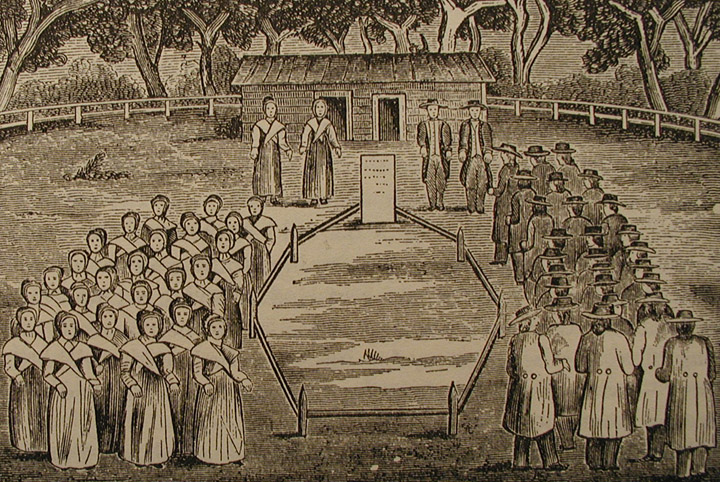
Shakers march around Fountain Stone on
Holy Hill of Zion
At the meetings the Brothers and
Sisters would symbolically bathe at the holy waters of the fountain, and
drink of it from invisible cups. They would have elaborate feasts of
spiritual foods such as exotic fruits and sip on invisible heavenly wine
that made them drunk.
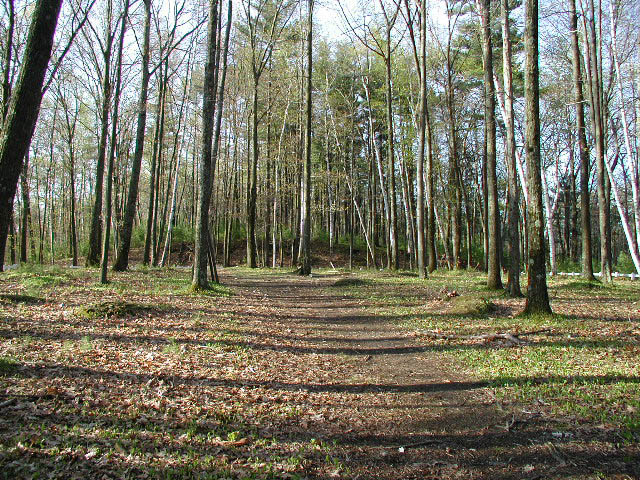
Same view today
They also imagined that they
were wearing fantastic costumes. For the Brethren these were costumes
of coats of twelve beautiful colors; sky-blue, gold-buttoned jackets;
white trousers spangled with stars; white shoes; and a silver fur hat.
For the Sisters these were imaginary gowns of twelve beautiful colors;
silver shoes; silver-colored bonnets; and blue silk gloves. They were
even given by the Elders invisible spectacles, the better to see the
invisible realities. Imaginary incense was poured over them, and
invisible mantles of strength were bestowed upon them. They received
caskets of spiritual treasures that they divided among themselves upon
the Holy Hill of Zion.
Under the Operations of the Spirits
The chosen
instruments of clairvoyance were typically young women from the ages of
13 to 25, although any Shaker who felt the Spirit move could bring
through the words and songs of the disembodied spirits. In fact, anyone
who did not willingly cooperate with the spirits who were manifesting at
a meeting was subjected to
"Warring Gift" where a Sister or Brother
would cry out at them,
"Woe woe! woe! to them that should leave the
ways of God, or oppose it!" This message would be accompanied by loud groanings.
The appearance of
the spirits was invoked by ecstatic dance: whirlings and spinnings
around the Fountain when on the Holy Hill, and rocking and clapping in
the Meeting Hall in inclement weather.
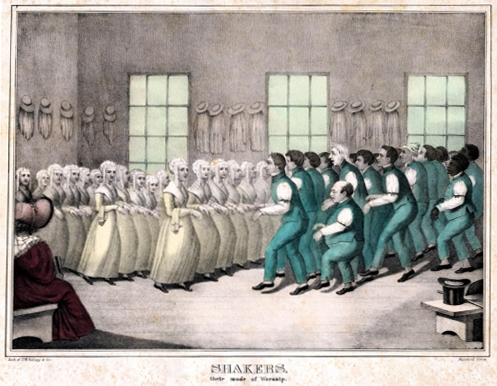
Shakers Dancing in the Meeting Hall
The Elders &
Eldresses of Lovely Vineyard (Blanchard, Orsment, Babbit, and Loomis)
would exhort the Brethren and Sisters to be zealous and labor
(meaning to dance or move ecstatically) for the
"Gifts of the Power of
God." As their zeal and labors increased, some would whirl in place or
rush rapidly back and forth, while others rolled on the ground. The
young Sisters were especially noted for spinning like tops.
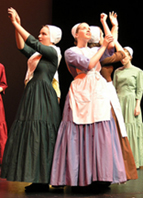 There would be
shouting and leaping, along with talking and singing in unknown
tongues. All the while the young Sisters would spin, spin, spin until
they would fall to the ground in violent spasms
"as though affected with
shocks of electricity." Whereupon they would subside into a swoon and
bring forth the words of the spirit world. Consider the following
example,
"her limbs became ridged, her face took on an ashen hue, her
lips moved, and she began to speak in a clear distinct voice." There would be
shouting and leaping, along with talking and singing in unknown
tongues. All the while the young Sisters would spin, spin, spin until
they would fall to the ground in violent spasms
"as though affected with
shocks of electricity." Whereupon they would subside into a swoon and
bring forth the words of the spirit world. Consider the following
example,
"her limbs became ridged, her face took on an ashen hue, her
lips moved, and she began to speak in a clear distinct voice."
When a
"chosen
instrument" was spoken of as being under
"operations" it meant jerking
of the head, bowing and twisting, rolling the eyes and contorting the
face and throwing the arms about.
The Gift was
contagious and soon the entire Meeting would be in the violent ecstatic
throes of the spirit world, which was a sight to behold. Indeed, Henry
Wadsworth Longfellow's wife compared a New Lebanon meeting to a
"Witch's
Sabbath."
The Thronging Spirits of Holy Hill
There was no limit
to the extraordinary number and breadth of the spirits who spoke and
attended the ecstatic dancing at the Holy Hill of Zion.
According to Clara Endicott
Sears in her book Gleanings From Old Shaker Journals these included,
"the apostles, the prophets of old, the famous dead of all nations – the
great among the Egyptians, Indian chiefs, Arab sheiks, the French
prophets – all these disembodied spirits held converse with the
worshipers through the chosen mediums and clairvoyants."
Spirits by the thousands thronged among them.
Recorded here on Holy Hill were the spirits of Christ, the Virgin Mary,
Noah, Abraham, Jeremiah, Isaiah, Mother Ann, and Angels of Truth,
Repentance, Peace, Prophesy, and Victory, and many other
"bright and
holy angels" including the
"two angels that drove the righteous Lot out
of Sodom." So too were the spirits of many departed Shakers and ancient
Saints. On another occasion
"40,000 such spirits were seen encircling
the hilltop like a great and mighty host of witnesses, and remained
there during the hours spent in worship."
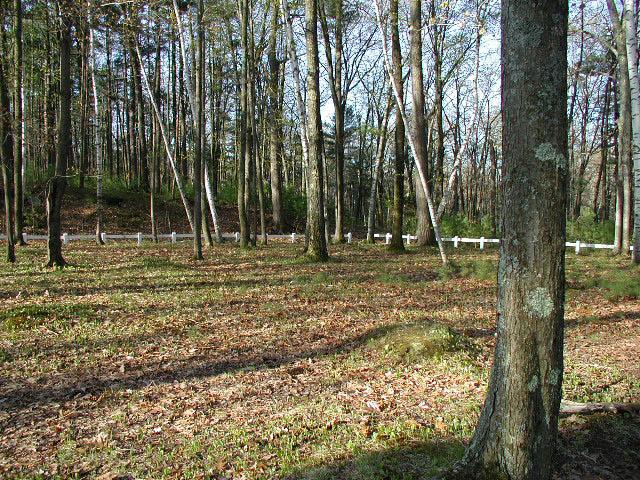
Where Spirits Thronged and Shakers
Danced
Holy Hill of Zion
In a more esoteric vein we learn that the
Mighty Angel of God is named: MA’NE ME’RAH VAK’NA SI’NA JAH. Linked to
this the four Angels of the Four Quarters of the Holy Hills of Shakerdom
are:
East: ASSAN’ DE LA JAH
South: VEN DEN’ DE PA’ ROL JEW’
LE JAH’
West: MI’CHAEL VAN’ CE VA’ NE
North: GA’ BRY VEN’ DO VAS’ TER
REEN’
The Shakers were very protective
of the Holy Hill and loathe to permit visits by non-believers. They
made "claim that here the supernatural revelations received were
starling clear and definite," and refused
entry to The World.
A further
"gift"
from the lead of New Lebanon around 1842 was the instruction that
meetings were now to be closed from the public view. So Holy were the
manifestations taking place that it was no longer deemed fit for The
World (the public) to observe them. The doors were closed and no public
admittance allowed for the next three years. Thus the times and doings
of the Holy Hills of Shakerdom were essentially cloaked to all but the
Brethren and Sisters alone.
Converting the Indians
The chosen instruments had
prophesied that that "hundreds & thousands" of "naked, hungry and needy"
souls would come to the Shakers for salvation, whether they were living
or dead did not seem to matter.
The New Era Shakers, much like
the Mormons, believed that the dead of all peoples could still be
converted to rest in heaven. The chosen instruments described them as
seeking salvation of the Shaker Ministry by the thousands. It seems
that the Indians were a favorite recipient of this Shaker belief.
In fact, a young female
instrument who, after 15 minutes of whirling in place, described a tribe
of "savage Indians" that had been "around two days," then instructed the
Meeting that "Mother Ann says to take in the poor spirits and assist
them to get salvation." This practice of assisting spirits pioneered by
Shakers is now known as a Rescue Circle in modern Spiritualist groups.
Crowds of Indians spirits were
said to have thronged the meetings and pressed for admittance. They
would be admitted collectively, and possessed the Shakers collectively.
Indian whoops would abound and entire Shaker communities would speak and
sing in pseudo-Indian languages, and dance pseudo-Indian dances. But
unlike other channeled spirits, the Indians did not seem to deliver any
teachings or messages. Rather, the Shakers came to the conclusion that
they had to teach and convert these spirits. And, according to the
chosen instruments, they did so by the thousands.
It was further communicated that the spirit Indians lived in the Blue
City, said to be on the closest plane "across the river" from the
material plane. "Question:
'What
city is this?'
Answer:
'The
Blue City.'
Question:
'Who
lives here?'
Answer:
'The
Indians.'
Question:
'Why
are they the first city we come to in the spirit-land, and most
accessible?'
Answer:
'Because
the Indians lived more in accordance with the law of nature…'"
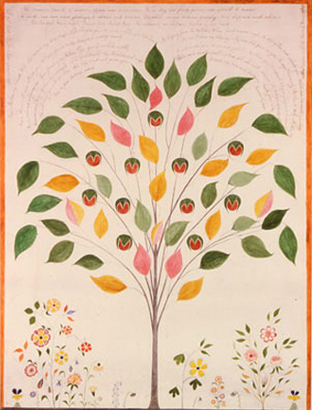
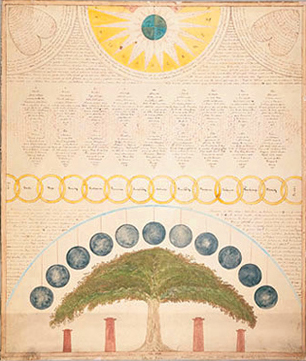
Gift Song & Gift Drawings
The designs and songs were considered
gifts of the spirit-world
A number of Indian "Gift Songs"
were recorded at this time. A representative example of this
stereotyped pidgin-English is He Haw Tallabo Tallabo:
He Haw tal-lab-o, He Haw tal-lab-o
haw,
Tink-a-tay ad-dle-um, i-did-dle
ad-dle-um.
Contrast this with the following
non-"Indian" Gift Song with a typically distinct Latin flavor:
O calvini criste I no vole,
Calvivi criste liste um,
I no vole vinin ne viste,
I no vole viste vum.
Spiritual Practices in the Lovely Vineyard
Further spirit-driven practices
in Harvard involved "gifts" from the "lead" in New Lebanon. For
instance, when spirit communication there instructed them to sow seeds
of Love, Truth, Hope, Charity (and all the virtues), this resulted in
the Brother and Sister Shakers in Harvard sowing invisible seeds the
length and breadth of their fields prior to planting real ones.
A Harvard Shaker diarist notes on October 19,
1842, that the entire community between the ages of 16 and 65,
"commenced sowing our farm with the seed of faith." And on November 12
of the same year, it was recorded that the
"Sisters sow the seed of
protection etc. on the Bigelow pasture and plain."
Gifts from the Spirit World were
common such as a ball of love or a basket of peace. Shaker Elders
traveling from New Lebanon would often distribute the contents of these
baskets to the Shaker communities they passed though. Some baskets
would be from Mother Ann or other departed Shaker spirits, and each
present was accompanied by attending angels. The baskets, gifts
therein, and the angels would be invisible to all but the chosen
instrument describing them to the recipients. On one occasion in
Harvard, each member received a invisible chain of gold which symbolized
love.
The Millerites Didn't Go Up
The New Era of
Mother Ann's Work shared a fervent religious landscape in
Massachusetts. The philosophical idealism of Ralph Waldo Emerson's
circle in Concord was in full swing, and Bronson Alcott's
Transcendentalist experimental farm at Fruitlands in Harvard was
spluttering away over the summer of 1843. In a
"season of wonders,"
spectacular comets lighted the night skies and Nashoba Hill in adjacent
Littleton made strange rumblings and boomings.
|
Nashoba Hill: The Hill That Roars -
Vision Quest and Nashoba Praying Indian Village
Presented at the
NEARA 2008 Fall Conference
by Daniel V. Boudillion
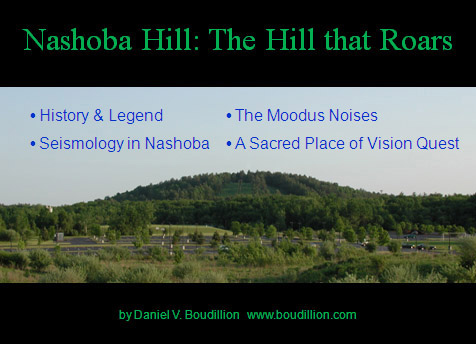 There
is a very special hill in Littleton Massachusetts that roars. The
Indians thought the winds were pent inside; the Colonials said it
sounded like cannons; some folks climbed it to await the rapture;
and others erected an altar stone on its top. It's a
well-known hill, famed these days for its ski slopes. But its
history is far more strange, and ongoing, than anything that has
ever swooshed down its slopes or taken the chair-lift. Gather
round the ski lodge fire, friends, and hear the strange tale of
Nashoba Hill: of a dark king under the mountain and an island
village of vision quests and shamans. There
is a very special hill in Littleton Massachusetts that roars. The
Indians thought the winds were pent inside; the Colonials said it
sounded like cannons; some folks climbed it to await the rapture;
and others erected an altar stone on its top. It's a
well-known hill, famed these days for its ski slopes. But its
history is far more strange, and ongoing, than anything that has
ever swooshed down its slopes or taken the chair-lift. Gather
round the ski lodge fire, friends, and hear the strange tale of
Nashoba Hill: of a dark king under the mountain and an island
village of vision quests and shamans.
Littleton,
Massachusetts was originally a Praying Indian Village. Back in 1646,
Rev. John Eliot, known as the Apostle to the Indians, began an effort to
organize the Massachusetts Indians into Christian Villages. With the
backing of Cromwell’s England and 12,000 pounds sterling, he began a
long-term mission to the Massachusetts and translated the Bible into
Algonquin in 1663.
Although he was a
Puritan, Eliot was also a humanitarian and he felt that the best way to
assure their survival in the midst of heavy English land-pressure was to
organize the Indians into English towns and lifestyles. They were to
convert to Christianity, have deeded towns, live in English houses, wear
English clothes, and worship Puritan style in Meeting houses.
For the rest of the article, see
here. |
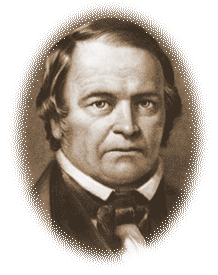 One town over in
Groton was one of the main
"encampments" of the Millerite Movement.
William Miller was a Vermont farmer who preached and prophesied the
coming end of the world, expected to happen between the vernal equinoxes
of 1843 and 1844. His message excited between 50 to 100,000 followers
in New England who sold their homes and belongings and climbed hills to
await being bodily lifted up to heaven with the advent of the
Millennium. When 1843 passed uneventfully, followed by an abortive
Ascension Day on the spring equinox of 1844, the End was meticulously
recalculated for October 22, 1844. When this date also passed without
event, many of the disillusioned followers joined the New England Shaker
Communities. Others went insane or committed suicide following the
"Great Disappointment." One town over in
Groton was one of the main
"encampments" of the Millerite Movement.
William Miller was a Vermont farmer who preached and prophesied the
coming end of the world, expected to happen between the vernal equinoxes
of 1843 and 1844. His message excited between 50 to 100,000 followers
in New England who sold their homes and belongings and climbed hills to
await being bodily lifted up to heaven with the advent of the
Millennium. When 1843 passed uneventfully, followed by an abortive
Ascension Day on the spring equinox of 1844, the End was meticulously
recalculated for October 22, 1844. When this date also passed without
event, many of the disillusioned followers joined the New England Shaker
Communities. Others went insane or committed suicide following the
"Great Disappointment."
There were
certainly similarities between the Shakers and Millerites. For one, the
Millerites believed the Millennium was imminent, while the Shakers
believed it had just happened and they were living in it as its Saints.
There was also a commonality of forgoing material works for spiritual
experience. Because they believed the end was nigh, the Millerites
simply forwent their farming chores. Instead they conjugated at
encampments reported at the time to have been regular boisterous
night-long bouts of religious singing and dancing, and even rolling on
the ground, not unlike what was happening in nearby Lovely Vineyard in
1843 and 1844.
It is no surprise
that many a disillusioned and now homeless Millerite found haven in the
dorm houses and ecstatic spiritual practices of Harvard's Shaker
Community.
End of the New Era
The New Era ended around 1844
almost abruptly as it began. The Holy Hill of Zion in Harvard had only
been fully completed on November 22, 1843, with the erection of the
Fountain Stone, and saw only a few years use all together. The last
mention in Shaker diaries of meetings there is the semiannual Feast on
May 6, 1844, only six months after its completion. After that there is
silence.
In many ways the ending had as
much to do with economics as politics. There is only so long a farming
community can neglect its crops with six hour every-other-day meetings.
And, the dynamics between the chosen instruments and the Shaker Elders
very much pitted those experiencing visions and gifts, most of whom
where young women, against a pragmatic leadership consisting of elderly
men and stern women.
In almost a fit of embarrassment
and irritation, the Shaker Holy Hills were abandoned – not by decree out
of New Lebanon – but more out of a mutual and unilateral decision to end
that chapter and face the hard realities of crumbing community economics
and diminishing memberships.
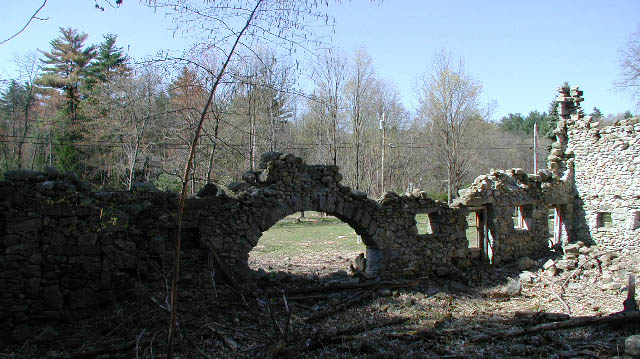
Ruins of the Harvard Shaker South
Family Barn
See original structure
here.
In Harvard, Elder Elijah Myrick, who
had lettered the Fountain Stone, quietly removed it one day and buried
somewhere on Harvard Shaker Lands. It has not been seen since, and he
left no record of its final resting place.
Departing for the World
Almost as if knowing the end was
in sight, the spirits who had provided and demanded so much obsession
and attention of the Shakers formally announced a withdrawal from the
Shaker Holy Places. They departed the Holy Hills to now manifest
themselves (in their own words) "in mighty floods upon the world's
peoples as stupendous tokens of spiritual presence."
The chosen instruments further
conveyed the message of the spirits that this would commence around 1848
with the discovery of "mines of treasure" which was supposed to be
actual mineral wealth from the earth to compliment the "down streaming
spiritual riches."
Right on schedule, 1848 saw the
California Gold Rush and a strange stirring of the supernatural starting
with two young girls, much like it had started among the Shakers. In
that year on March 31st in Arcadia (Hydesville), New York,
Katie and Maggie Fox came into communication with a mysterious spirit
who rapped on the walls of their house. And thus, modern Spiritualism
was born and swept the Western world, and the Spiritualist Church was
begun. The credit for Spiritualism went to the Fox sisters, but the
Shakers always maintained that it was their spirits that had
tapped back.
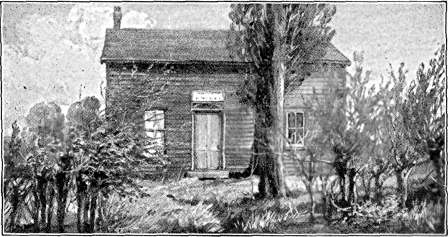
Home of the Fox Sisters, Arcadia, New
York
Interestingly, the
Fox farm was only seven miles from Palmyra, New York, the birthplace of
Mormonism, where its founder Joseph Smith experienced his visions from
1820 to 1827. This is
only a few miles south of the Sodus Point Shaker Community. Watervliet,
where the New Era first made itself known, is about 100 miles to the
East.
A interesting note is that this
entire area of New York was known as the Burned Over district due to the
successive waves of religious revival that had swept over it so often.
It was considered by the 1820's to be an area of few pickings by the
revivalists, so jaded to it were its inhabitants. And yet three
significant spirit-originated movements began here afterwards: Mormonism
in the 1820's, the New Era of Shakerdom in the 1830's, and Spiritualism
in the 1840's.
Spiritualism Killed Shakerism?
There are a
multitude of factors that sent Shakerdom into decline in the years
following the New Era of Mother Ann's Work. One interesting theory is
that in the 1860's there
"was an ideological challenge that threatened
to change Shaker views on celibacy and to destroy the structure of the
Shaker community."
This outbreak of
discontent was a result of the popular new Spiritualist Movement and
their attractive message that there could be reconciliation between the
physical world and the spiritual world – between the flesh and
worshiping God.
At New Lebanon,
always at the
"lead" in all things Shaker, a group of young Believers in
1864 unsuccessfully advocated for a union between flesh and spirit.
Similar discontent arose at
Hancock, Massachusetts, and a number of
similar uprisings against the strictness of the separation of flesh and
god resulted in many expulsions in Shaker communities.
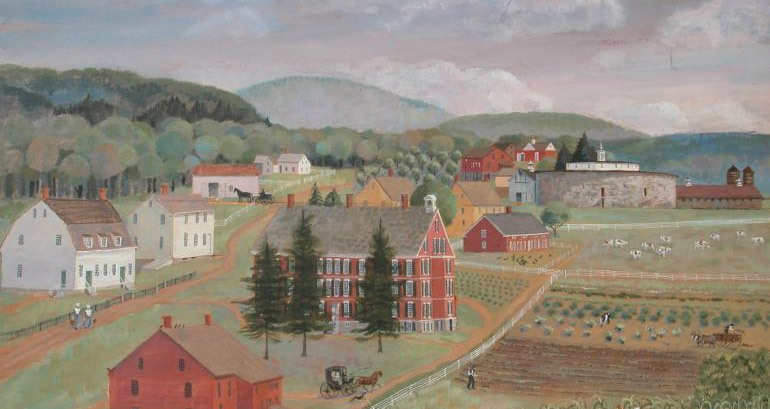
Hancock Shaker Village, Massachusetts
by
Katie Berry
More and more the
Shaker conditions of living in complete celibacy and constant perfection
were unacceptable by the younger members and increasingly unattainable.
With the abrupt end of the New Era and its hours of almost daily
ecstatic dance and spirit communication, there was little area to
channel the life energies creatively. The number of apostates grew, and
the Shaker suicide rates rose above the state rates.
Still Interested in Spirits
In another odd turn of events,
the prevalence of Spiritualism in mainstream culture by the mid 1850's
was such that its terms and practices fed back into the Shaker world,
with the Shakers adopting them. Cyrus O.
Poole comments in 1887 that:
"What is now known
as Modern Spiritualism is accepted by them [Shakers] as a fact. They
assert that all phases of mediumship were common among them several
years prior to the first raps at Hydesville, and that its advent to the
general public was then foretold. In its higher phases it is still
sometimes exhibited."
Indeed, the Shaker movement
maintained a life-long history of interest in the spirit world. It only
peaked as an obsession in itself during the New Era from 1837 to 1844.
But afterwards the interest is clearly shown to be alive, but it is not
a participant interest the way that the chosen instruments participated
in ecstatic dance and mediumship. Rather, from time to time individual
Shakers went to or entertained Spiritualist Mediums. The final recorded
mention of the Holy Hill of Zion in a spirit sense comes from a Harvard
Shaker diary dated September 26, 1882:
"I go to the Holy Hill of Zion with two lady
mediums and Roxalana. Had a wonderful message in relation to that
consecrated place. Prophecies of its future much like I have heard time
to time by the most reliable mediums in the past when we had a wonderful
influx from the spirit sphere."
Sadly, this prophesy has not come to fruition
in the 125 years since it was uttered. The only spirits
who haunt the place today are the woodland
ones of deer and fox and owl.
The Holy Hill of Zion Today
The Holy Hill of
Zion is owned by the Town of Harvard, and may be visited by a trailhead
accessed on South Shaker Road. The exact GPS location of the dancing
ground on Holy Hill is 42.5350N, -715620W.
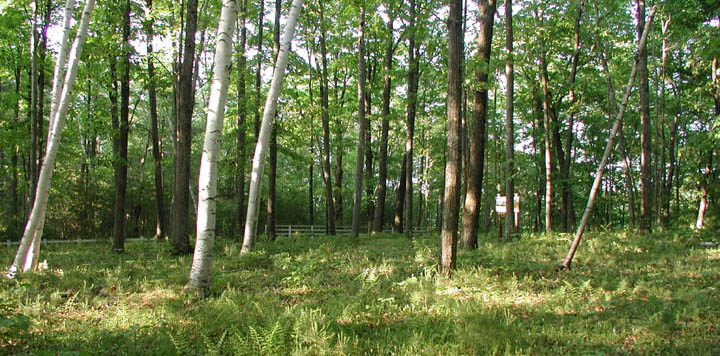
Holy Hill of Zion Dancing Ground
Today the dancing
ground on the Holy Hill is covered in trees, although cleared of brush.
A new white fence has been erected around it. The old iron ties of the
original fence may still be found embedded into the old footing stones.
The Fountain Stone has long since been secreted way from the profane
eyes of The World by Elder Myrick. But its slotted footing stone
remains. This stone marks the northernmost end of the Fountain area,
and thus its rough dimensions can still be traced on the ground by those
interested in doing so.
Several dozen feet
in the woods from the Southwest corner of the dancing ground is a lone
scattered heap of stones. It is known that some Fountains, notably at
Hancock, included a pile of stones placed there by the Believers during
their ceremonies. Perhaps this lone pile is the carted off remains of
one such ritual in Harvard.
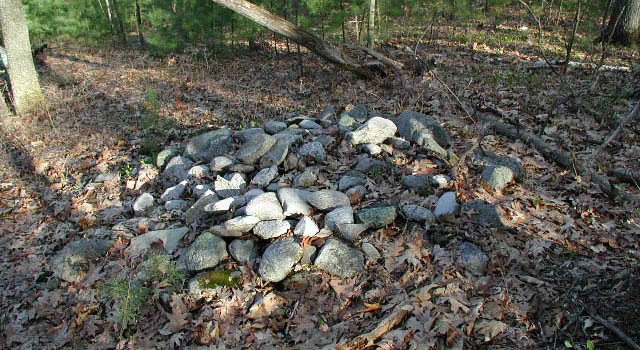
Stones from the
"Fountain?"
I have spent many
a contemplative spring or autumn afternoon at the dancing ground. It is
not uncommon to see deer, and nature lovers wander though several times
a day on their excursions.
There is
unquestionably a spiritual power that remains here, possibly due to the
channel that was carved to the Spirit World by fervency and zeal in the
1840's, or a sacred energy that has always resided at this place.
Indeed, I know of people who have whirled the night away here, same as
the young Sisters did 150 years ago. Others come to meditate. If one
were to wear one of the marvelous old imaginary glasses that helped the
Believers view the spirit world Holy Hill, I am sure they would still
see the dancing ground as a beacon of spiritual power. For those of us
without access to such aids there is still a palatable feeling of
proximity to the Unseen.
Some have
attempted recordings of the so-called spirit voice phenomena at the site
of the Fountain Stone. This is a process called Electronic Voice
Phenomena where recoding tape seemingly picks up voices not heard with
the physical ear at the time of recording. But with what results I do
not know.
The foot of the
Fountain Stone still stands in mute testimony to the extraordinary and
fervent days of whirling Sisters and thronging spirits, having all here
given good measure to a powerful belief that culminated in ecstatic
heights unknown to the common run of human kind.
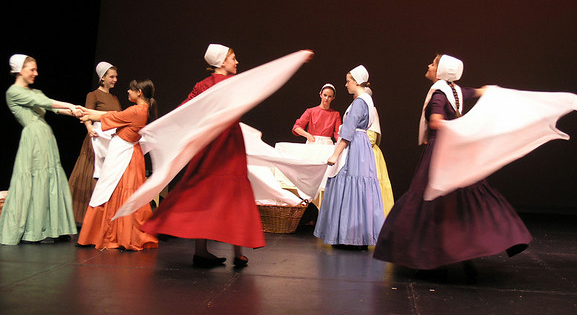
From the play "As it is in Heaven" by Arlene Hutton
To quote Flo
Morse, who is herself quoting Shaker sources,
"By
the mid-1840's the Shakers had given good measure to a 'Swift winged'
Holy Angel, who had demanded, 'More zeal, more life, more fervency, more
energy, more love, more thankfulness, more obedience, more strength,
more power!'"
This is Holy
Ground of an uncommon and ecstatic type; tread here at your peril lest
ye also dance.
Email Daniel V.
Boudillion
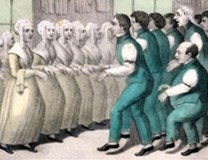
Back to Field
Journal
Copyright © 2007, 2009 by Daniel V. Boudillion
| 
 The United Society
of Believers in Christ's Second Appearing first came to Harvard,
Massachusetts, from England in 1781. They were searching for a place
that their leader,
The United Society
of Believers in Christ's Second Appearing first came to Harvard,
Massachusetts, from England in 1781. They were searching for a place
that their leader, 


















 There would be
shouting and leaping, along with talking and singing in unknown
tongues. All the while the young Sisters would spin, spin, spin until
they would fall to the ground in violent spasms
There would be
shouting and leaping, along with talking and singing in unknown
tongues. All the while the young Sisters would spin, spin, spin until
they would fall to the ground in violent spasms 










